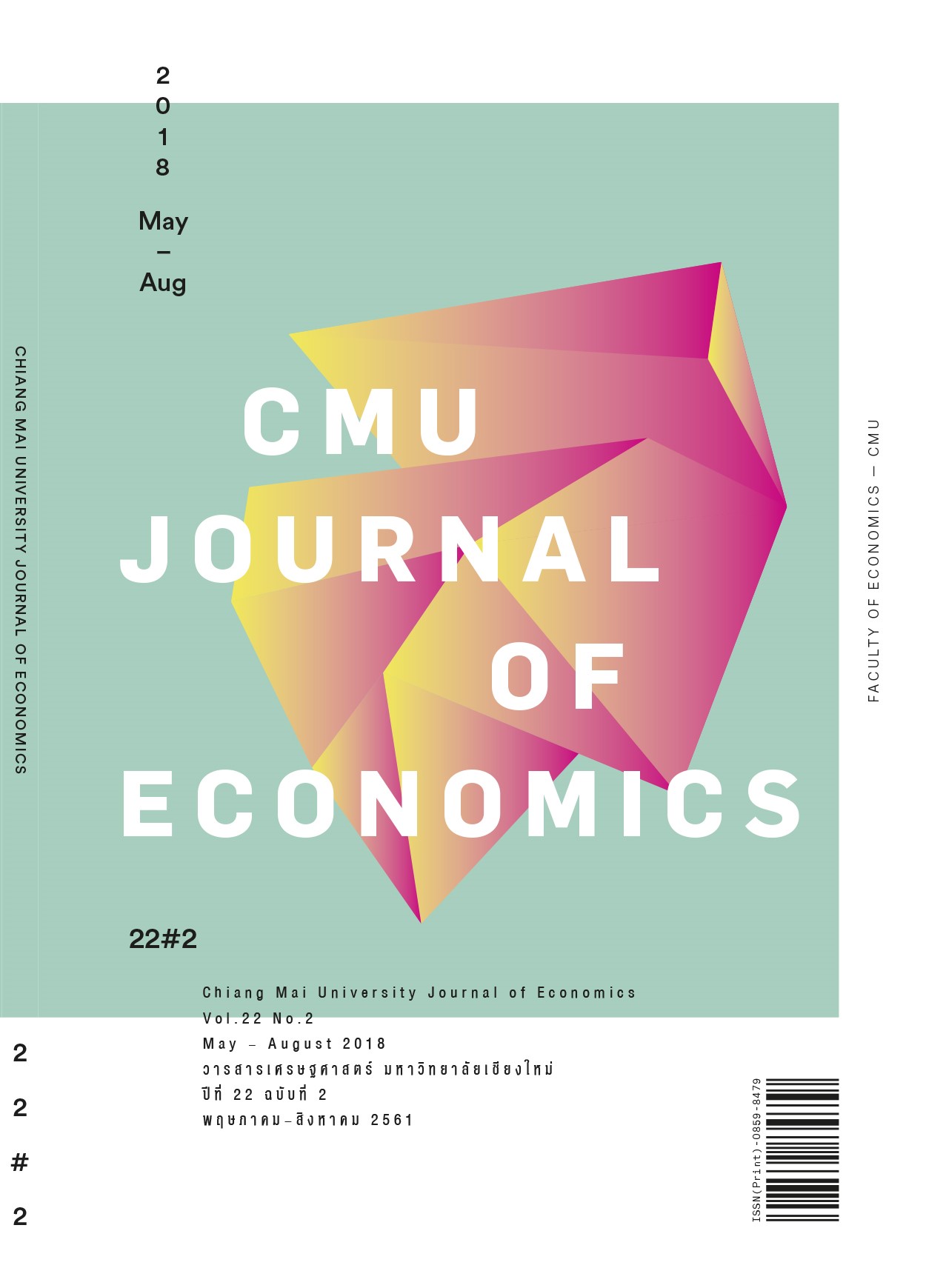Business Cycle with Structural Changes in ASEAN-5
Keywords:
Business cycle, Markov-switching, Impulse response analysis, Structural breakAbstract
This study is conducted to examine a business cycle of ASEAN-5 countries namely Thailand, Indonesia, Malaysia, Singapore, and the Philippines, which are the main drivers for ASEAN's economy. This study focuses on a business cycle synchronization among the ASEAN-5 countries because it is a key to successful economic integration. Markov-switching Vector Autoregressive (MS-VAR) is used to detect the nonlinear stochastic process of the business cycle as it provides a flexible framework which allows determining a structural break and capturing interdependencies among multiple time series. The data used in this study include industrial production index (IPI) and gross domestic product (GDP) spanning from the first quarter of 1981 to the second quarter of 2014 of the ASEAN-5 countries. In addition, this study determines a regime generating process and investigates which part of the business cycle that leads to a shift from the expansion to the recession and predicts economic growth.
The estimated result shows the existence of a common business cycle of the ASEAN-5 countries. Their economies mainly stay in the expansion with a probability of 0.94. However, there exists a chance of transitioning from the expansion to the recession which is equal to 0.16 due to the global economic crises. Moreover, our finding reveals that the existing regime switching can be explained by changes in intercept term and variance for a case of the GDP growth cycle while a regime switching in the IPI growth cycle is explained by a change in the autoregressive parameter. Then, we predict the economic growth for the ASEAN-5 countries and find that their GDP growth will continue to grow with the rate of about 8 to 16 per cent and nearly 1 to 2 per cent for the IPI growth. Lastly, when we undertake an impulse response analysis and find that each country is more sensitive to the shock of themselves than the shocks due to recession occurred in other countries.
งานวิจัยฉบับนี้จัดทำขึ้นเพื่อศึกษาวัฏจักรเศรษฐกิจและความสอดคล้องกันของวัฏจักรเศรษฐกิจในกลุ่มประเทศอาเซียน-5 ได้แก่ ไทย อินโดนีเซีย มาเลเซีย สิงคโปร์ และฟิลิปปินส์ ซึ่งเป็นกลุ่มประเทศสำคัญที่ขับเคลื่อนเศรษฐกิจของอาเซียน เนื่องจากความสอดคล้องกันของวัฏจักรเศรษฐกิจของประเทศสมาชิกภายในกลุ่มถือเป็นเงื่อนไขประการหนึ่งของความสำเร็จในการรวมกลุ่มเศรษฐกิจที่มีการบูรณาการนโยบายทางเศรษฐกิจร่วมกัน การศึกษาในครั้งนี้ได้เลือกใช้แบบจำลองในกลุ่ม Markov-switching Vector Autoregressive (MS-VAR) มาเป็นเครื่องมือที่ใช้ในการศึกษาเนื่องจากวัฏจักรเศรษฐกิจมีลักษณะไม่เป็นเชิงเส้นตรง (Non-linear) และมีความผันผวนภายในวัฏจักร MS-VAR เป็นเครื่องมือที่มีความสามารถสูงในการวิเคราะห์วัฏจักรเศรษฐกิจเนื่องจากสามารถพิจารณา Structural Break ที่มีความผันผวนและวิเคราะห์ความสัมพันธ์ร่วมของหลายตัวแปรพร้อมกันได้ โดยทำการศึกษาใน 2 สถานะ ได้แก่ สถานะเศรษฐกิจขยายตัว และสถานะเศรษฐกิจถดถอย ร่วมกับตัวแปรในกลุ่มดัชนีเศรษฐกิจที่แสดงระดับกิจกรรมทางเศรษฐกิจ ได้แก่ ตัวแปรดัชนีผลผลิตภาคอุตสาหกรรมและตัวแปรมูลค่าผลิตภัณฑ์มวลรวมภายในประเทศเป็นรายไตรมาส ตั้งแต่ไตรมาสที่ 1 พ.ศ. 2524 ถึง ไตรมาสที่ 2 พ.ศ. 2557 เพื่อศึกษาการเคลื่อนไหวของระดับกิจกรรมทางเศรษฐกิจที่ผ่านมาในรูปแบบวัฏจักรของประเทศในกลุ่มอาเซียน-5 นอกจากนี้ งานวิจัยฉบับนี้ยังได้ทำการศึกษาวัฏจักรเศรษฐกิจของอาเซียน-5 ในภาพรวม ในเชิงการปรับโครงสร้างเพื่อศึกษาว่าการเปลี่ยนสถานะทางเศรษฐกิจจากเศรษฐกิจขยายตัวมาสู่เศรษฐกิจถดถอยหรือในทางตรงข้าม มีสาเหตุมาจากโครงสร้างในส่วนใดภายในวัฏจักรเศรษฐกิจ และนำผลการศึกษาที่ได้ไปทำการพยากรณ์ภาวะเศรษฐกิจของอาเซียน-5
จากผลการศึกษา พบว่า ประเทศสมาชิกในกลุ่มอาเซียน-5 มีวัฏจักรเศรษฐกิจที่ค่อนข้างสอดคล้องกัน โดยมีเศรษฐกิจส่วนใหญ่ดำเนินอยู่ในสถานะเศรษฐกิจขยายตัว ด้วยความน่าจะเป็นเฉลี่ยประมาณ 0.94 แต่พบว่ามีความน่าจะเป็น 0.16 ที่จะมีการปรับเข้าสู่สถานะเศรษฐกิจถดถอยโดยมีสาเหตุสำคัญมาจากการเกิดวิกฤตเศรษฐกิจโลก นอกจากนี้ในการศึกษาวัฏจักรเศรษฐกิจของอาเซียน-5 ในภาพรวมเชิงโครงสร้าง พบว่า การเปลี่ยนสถานะของอัตราการเติบโตของ GDP ของอาเซียน-5 สามารถอธิบายได้ด้วยพจน์ภาคตัดขวาง (Intercept Term) และ ความแปรปรวนของข้อมูล (Variance) และการเปลี่ยนสถานะของอัตราการเติบโตของ IPI ของอาเซียน-5 สามารถอธิบายได้ด้วยค่าสัมประสิทธิ์การถดถอยของตัวแปร (Autoregressive Parameter) นอกจากนี้ เมื่อทำการพยากรณ์ภาวะเศรษฐกิจของอาเซียน-5 ไปจนถึงไตรมาสที่ 2 พ.ศ. 2559 พบว่า เศรษฐกิจของอาเซียน-5 มีแนวโน้มที่จะคงอยู่ในสถานะเศรษฐกิจขยายตัวต่อไปเรื่อย ๆ โดยมีอัตราการเติบโตเฉลี่ยประมาณ ร้อยละ 8 ถึง 16 สำหรับ GDP และมีอัตราการเติบโตเฉลี่ยประมาณ ร้อยละ 1 ถึง 2 สำหรับ IPI และเมื่อตรวจสอบการตอบสนองต่อการเปลี่ยนแปลงอย่างฉับพลัน (Shocks) ของประเทศในกลุ่มอาเซียน-5 พบว่า ประเทศในกลุ่มอาเซียน-5 มีการตอบสนองต่อการเกิด Shocks ของประเทศอื่น ๆ ในระดับน้อยในขณะที่มีการตอบสนองต่อการเกิด Shocks ของประเทศตนเองอย่างมากก่อนที่จะมีการปรับตัวเข้าสู่ดุลยภาพเมื่อเวลาผ่านไป
References
Artis, M., Krolzig, H-M., & Toro, J. (2004). The European business cycle. Oxford Journal, Oxford Economic Papers, 56 (1), 1-44. Retrieved September 4, 2013, from https://oep.oxfordjournals.org/content/56/1/1.short
Association of Southeast Asian Nations. (2012). ASEAN statistical yearbook 2012. Retrieved September 4, 2013, from https://www.asean.org/images/2013/resources/statistics/statistical_publication/ASEANStatisticalYearbook2012.pdf
Balasubramaniam, A., Puah C. H., & Mansor, S. A. (2011). Economic interdependence: evidence from China and ASEAN-5 countries. Journal of Modern Economy, 3, 122-125. doi: 10.4236/me.2012.31017
Birchenhall, C. R., Jessen H., Osborn D. R., & Simpson, P. (1999). Predicting U.S. business cycle regimes. Journal of Business and Economic Statistic 17, 313-323.
Burns, A. F., & Mitchell, W. C. (1946). Measuring Business Cycle. New York: National
Bureau of Economic Research. Retrieved September 4, 2013, from https://papers.nber.org/books/burn46-1
Chancharat, S. (2011). International Economic Cooperation: Faculty of Management Science, Khon Kaen University. (in Thai).
Cortinhas C. (2005). Intra-Industry Trade, Specialisation and Business Cycles in ASEAN. Retrieved November 5, 2013, from https://www.nottingham.ac.uk/gep/documents/conferences/2005/pg-conf/cortinhas-postgrad05.pdf
De Medeiros, O. R., & Sobral, Y. D. (2007). A markov switching regime model of the brazilian business cycle. Rochester: Social Science Research Network. Retrieved September 4, 2013, from https://dx.doi.org/10.2139/ssrn.969503
Dufrenot, G., & Keddad, B. (2013). Business cycles synchronization in east Asia: a markov-switching approach (AMSE Working Papers 1344). Marseille, France: Aix-Marseille School of Economics. Retrieved November 6, 2013, from https://www.amse-aixmarseille.fr/sites/default/files/_dt/2012/wp_2013_-_nr_44.pdf
Khanthavit A. (2009). Thailand’s business cycle forecasting. Financial engineering in Thailand’s financial market: 72 years Accountancy Thammasat 36 years. Bangkok: Faculty of Commerce and Accountancy, Thammasat University. (in Thai).
Krolzig, H-M. (1997). Markov switching vector autoregressions: modelling, statistical inference and application to business cycle analysis. Berlin: Springer. Retrieved September 4, 2013, from https://down.cenet.org.cn/upfile/8/200581232539112.pdf
Krolzig, H-M., & Toro, J. (2000). Classical and Modern Business Cycle Measurement: the European Case (Working Paper). Department of Economics, University of Oxford. Retrieved September 4, 2013, from https://www.economics.ox.ac.uk/materials/working_papers/paper060.pdf
Lestari, E. P., & Triani, L. F. (2013). Trade and business cycle synchronization in ASEAN-5 and China. International Proceedings of Economics Development and Research, 65(16), 77-80. Retrieved November 5, 2013, from https://www.ipedr.com/vol65/016-ICEBI2013-Y10021.pdf
Louis, R. J., & Simons, D. (2005). Does a north American business cycle exist ?. Canadian Journal of Economics, 38. Retrieved September 4, 2013, from https://economics.ca/2005/papers/0104.pdf
Madhani, P. M. (2010). Rebalancing Fixed and Variable Pay in a Sales Organization: a Business Cycle Perspective. Journal of Compensation and Benefits Review, 43, 245-258. Retrieved September 5, 2013, from https://cbr.sagepub.com/content/42/3/179.abstract
Ong, H. W., Puah C. H., & Habibullah, M. S. (2004). Business Cycles in the US and Five ASEAN Countries: are They Related ?. Journal of the Philippine Review of Economics, 41(1). Retrieved November 6, 2013, from https://ideas.repec.org/a/phs/prejrn/v41y2004i1p57-66.html
Paolillo, R. M., & Petragallo, N. (2004). Asymmetrics of Monetary Policy Transmission between US and Euro Area. Retrieved September 4, 2013, from https://www.cass.city.ac.uk/_data/assets/pdf_file/0005/65174
/PaolilloPetragallo.pdf
Smith, C. E. (2009). Encyclopedia of business in today’s world. Retrieved September 5, 2013, from https://www.answers.com/topic/economic-indicator
Trung, T-T. (2006). Determinants of Business Cycle Synchronization in ASEAN-5 Countries. Retrieved November 6, 2013, from https://editorialexpress.com/cgibin/conference/download.cgi?db_name=SERC2007&paper_id=9
Downloads
Published
Issue
Section
License
All opinions and contents in the CMJE are the responsibility of the author(s). Chiang Mai University Journal of Economics reserves the copyright for all published materials. Papers may not be reproduced in any form without the written permission from Chiang Mai University Journal of Economics.
ข้อคิดเห็นที่ปรากฏและแสดงในเนื้อหาบทความต่างๆในวารสารเศรษฐศาสตร์มหาวิทยาลัยเชียงใหม่ ถือเป็นความเห็นและความรับผิดชอบโดยตรงของผู้เขียนบทความนั้นๆ มิใช่เป็นความเห็นและความรับผิดชอบใดๆของวารสารเศรษฐศาสตร์ มหาวิทยาลัยเชียงใหม่
บทความ เนื้อหา และข้อมูล ฯลฯ ในวารสารเศรษฐศาสตร์มหาวิทยาลัยเชียงใหม่ ถือเป็นลิขสิทธิ์เฉพาะของคณะเศรษฐศาสตร์มหาวิทยาลัยเชียงใหม่ หากบุคคลหรือหน่วยงานใดต้องการนำทั้งหมดหรือส่วนหนึ่งส่วนใดไปเผยแพร่ต่อหรือเพื่อกระทำการใดๆ จะต้องได้รับอนุญาตเป็นลายลักษณ์อักษร จากวารสารเศรษฐศาสตร์ มหาวิทยาลัยเชียงใหม่






